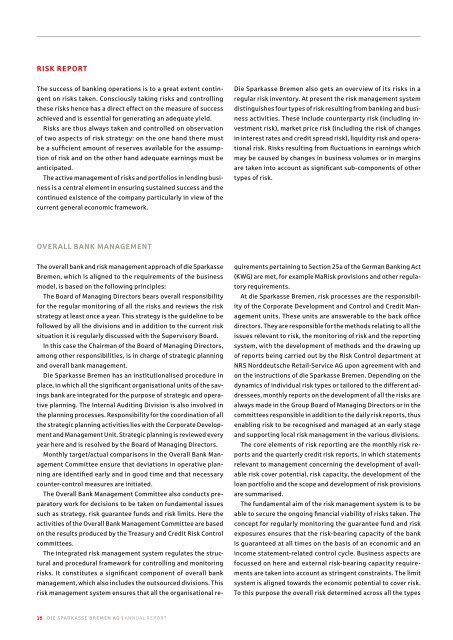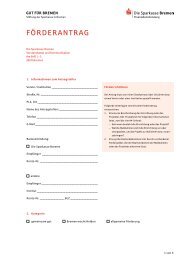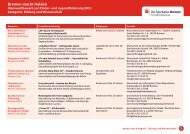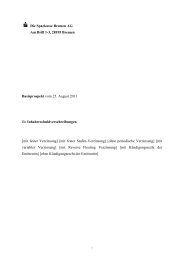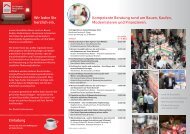Report from Bremen - Sparkasse Bremen
Report from Bremen - Sparkasse Bremen
Report from Bremen - Sparkasse Bremen
Create successful ePaper yourself
Turn your PDF publications into a flip-book with our unique Google optimized e-Paper software.
isk rePOrT<br />
the success of banking operations is to a great extent contin-<br />
gent on risks taken. Consciously taking risks and controlling<br />
these risks hence has a direct effect on the measure of success<br />
achieved and is essential for generating an adequate yield.<br />
Risks are thus always taken and controlled on observation<br />
of two aspects of risk strategy: on the one hand there must<br />
be a sufficient amount of reserves available for the assumption<br />
of risk and on the other hand adequate earnings must be<br />
anticipated.<br />
the active management of risks and portfolios in lending business<br />
is a central element in ensuring sustained success and the<br />
continued existence of the company particularly in view of the<br />
current general economic framework.<br />
OVerall Bank managemenT<br />
the overall bank and risk management approach of die <strong>Sparkasse</strong><br />
<strong>Bremen</strong>, which is aligned to the requirements of the business<br />
model, is based on the following principles:<br />
the Board of Managing Directors bears overall responsibility<br />
for the regular monitoring of all the risks and reviews the risk<br />
strategy at least once a year. this strategy is the guideline to be<br />
followed by all the divisions and in addition to the current risk<br />
situation it is regularly discussed with the Supervisory Board.<br />
In this case the Chairman of the Board of Managing Directors,<br />
among other responsibilities, is in charge of strategic planning<br />
and overall bank management.<br />
Die <strong>Sparkasse</strong> <strong>Bremen</strong> has an institutionalised procedure in<br />
place, in which all the significant organisational units of the savings<br />
bank are integrated for the purpose of strategic and operative<br />
planning. the Internal Auditing Division is also involved in<br />
the planning processes. Responsibility for the coordination of all<br />
the strategic planning activities lies with the Corporate Development<br />
and Management unit. Strategic planning is reviewed every<br />
year here and is resolved by the Board of Managing Directors.<br />
Monthly target/actual comparisons in the overall Bank Management<br />
Committee ensure that deviations in operative planning<br />
are identified early and in good time and that necessary<br />
counter-control measures are initiated.<br />
the overall Bank Management Committee also conducts preparatory<br />
work for decisions to be taken on fundamental issues<br />
such as strategy, risk guarantee funds and risk limits. Here the<br />
activities of the overall Bank Management Committee are based<br />
on the results produced by the treasury and Credit Risk Control<br />
committees.<br />
the integrated risk management system regulates the structural<br />
and procedural framework for controlling and monitoring<br />
risks. It constitutes a significant component of overall bank<br />
management, which also includes the outsourced divisions. this<br />
risk management system ensures that all the organisational re-<br />
16 Die sParkasse <strong>Bremen</strong> ag | AnnuAl RepoRt<br />
Die <strong>Sparkasse</strong> <strong>Bremen</strong> also gets an overview of its risks in a<br />
regular risk inventory. At present the risk management system<br />
distinguishes four types of risk resulting <strong>from</strong> banking and business<br />
activities. these include counterparty risk (including investment<br />
risk), market price risk (including the risk of changes<br />
in interest rates and credit spread risk), liquidity risk and operational<br />
risk. Risks resulting <strong>from</strong> fluctuations in earnings which<br />
may be caused by changes in business volumes or in margins<br />
are taken into account as significant sub-components of other<br />
types of risk.<br />
quirements pertaining to Section 25a of the German Banking Act<br />
(KWG) are met, for example MaRisk provisions and other regulatory<br />
requirements.<br />
At die <strong>Sparkasse</strong> <strong>Bremen</strong>, risk processes are the responsibility<br />
of the Corporate Development and Control and Credit Management<br />
units. these units are answerable to the back office<br />
directors. they are responsible for the methods relating to all the<br />
issues relevant to risk, the monitoring of risk and the reporting<br />
system, with the development of methods and the drawing up<br />
of reports being carried out by the Risk Control department at<br />
nRS norddeutsche Retail-Service AG upon agreement with and<br />
on the instructions of die <strong>Sparkasse</strong> <strong>Bremen</strong>. Depending on the<br />
dynamics of individual risk types or tailored to the different addressees,<br />
monthly reports on the development of all the risks are<br />
always made in the Group Board of Managing Directors or in the<br />
committees responsible in addition to the daily risk reports, thus<br />
enabling risk to be recognised and managed at an early stage<br />
and supporting local risk management in the various divisions.<br />
the core elements of risk reporting are the monthly risk reports<br />
and the quarterly credit risk reports, in which statements<br />
relevant to management concerning the development of available<br />
risk cover potential, risk capacity, the development of the<br />
loan portfolio and the scope and development of risk provisions<br />
are summarised.<br />
the fundamental aim of the risk management system is to be<br />
able to secure the ongoing financial viability of risks taken. the<br />
concept for regularly monitoring the guarantee fund and risk<br />
exposures ensures that the risk-bearing capacity of the bank<br />
is guaranteed at all times on the basis of an economic and an<br />
income statement-related control cycle. Business aspects are<br />
focussed on here and external risk-bearing capacity requirements<br />
are taken into account as stringent constraints. the limit<br />
system is aligned towards the economic potential to cover risk.<br />
to this purpose the overall risk determined across all the types


